
Travel Logbook
Page 1 2 3 4 5 6 7 8 9 10
Auckland, Waitomo & Rotorua, New Zealand: 18th-23rd February.
I arrived in Auckland, unknowingly, just as the Americas Cup final showdown, between Team New Zealand and Prada of Italy, was about to start. Although the racing was much too far away to be seen from the Auckland waterfront, there was a good buzz around the town with plenty of beer and entertainment in the Americas Cup village down in the marina. I spent a few days in Auckland while I decided what I wanted to see in my month in New Zealand, then took a bus south to Waitomo. There I visited the gloworm caves, where a guide shows you round some run-of-the-mill cave formations before you get into a boat to float through the gloworm grotto. This is spectacular, with thousands of tiny blue-green lights shining out from the darkness, picking out the 3-dimensional shapes of the stalagtites hanging from the cavern roof as the boat glides silently underneath.
That night I reached Rotorua, an area of intense thermal activity, so much so that the air in the town smells of sulphur. Next day I visited a thermal reserve and Maori cultural village called Whakarewarewa, or Whaka for short. To pronounce it properly, replace the Wha- with Fu- and you'll be nearly there. Yes, I know it sounds rude but don't blame me, that's just the way it is...
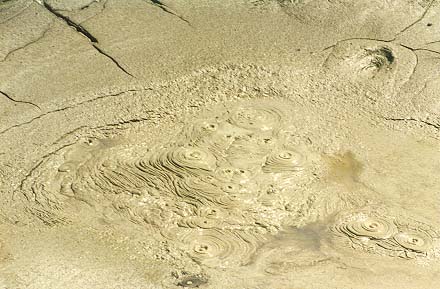
In the reserve I watched a very touristy Maori cultural show, then went to watch the Pohutu geyser. It normally spouts water 20m into the air every hour, but I watched it for a whole hour and, although still impressive, the water didn't get much higher than five metres. Later on I was speaking to a couple at my hostel who said a guide had told them that the lack of activity from the geyser meant there must be some increased volcanic activity somewhere else in the world. I couldn't see how activity thousands of miles away could possibly affect a small geyser in New Zealand, but apparently there was indeed a volcanic eruption in Iceland that very day...
Tongariro Northern Circuit & Wellington: 26th February-2nd March.

Next I moved on to Taupo for a day before starting a three day tramp on the Tongariro Northern Circuit. For the first day I walked with a group of friends I'd met in Rotorua. The track climbed up a saddle between the dormant volcanoes of Tongariro and Ngaurahoe and up to a summit overlooking the Red Crater, so called because the walls of the steaming vent are a bright red colour. The track then descended steeply on scree slopes past the brilliantly coloured Emerald Lakes, around some old lava flows and past another lake before descending to the Ketetahi hut. From here there were amazing views over Lake Taupo and I spent the night there while my companions, who were doing a day walk, headed back to Taupo.
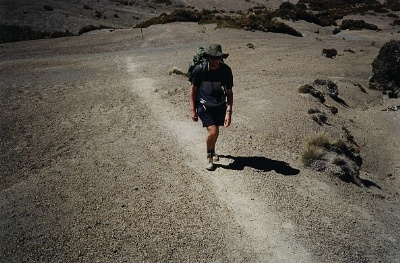
Breakfast next morning consisted of porridge, but I'd forgotten to bring any sugar and it tasted terrible. You're not allowed to leave any food scraps as they encourage vermin into the huts, so having made the porridge it was a choice between eating the foul stuff or carrying it around in my backpack for two days. I chose to force it down. I set out for the day's walk with an English guy called Nick I met in the hut. We climbed back up to the Emerald Lakes before following the Northern Circuit trail down through lava flows around the flanks of Ngaurahoe. The track passed through an arid landscape with great views of Mt. Ruapehu (another active volcano) and the Rangipo desert. At the end of the day the trail descended into sweet-smelling beech forest. As I walked through the trees, I was accompanied by a little Fantail, the tiny bird swooping around my head hoping to feast on the insects I was attracting.
I stopped for the night at the Waihohonu hut, but Nick carried on to find a suitable site to pitch his tent. Next morning I carried on by myself, and walking on my own gave me plenty of time to ponder what the bloody hell I was doing. No really, it was well worth it. I walked for five hours before reaching the end of the track at the village of Whakapapa (remember that pronunciation...)
After finishing the tramp I returned briefly to Taupo to pick up my things, then took the bus down to Wellington. There I met up briefly with Ben, Linda & Christina, some of the guys I walked the first day of Tongariro with. I spent one day in Wellington, during which I went to the National Museum, Te Papa, with Christina. Next day we caught the Lynx ferry to Picton on the South Island.
Fox Glacier, Queenstown & the Kepler Track, South Island: 2nd-11th March.
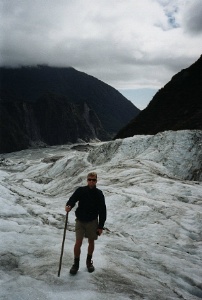
I then made my way down the west coast of the island, stopping for a night in Nelson before continuing down the spectacular coast to the village of Fox. Here I took a guided walk on the Fox Glacier. We were given crampons and a pole with a spike on the end to help us keep our grip on the slippery steps carved into the ice by our guide. Unlike those in the Alps, New Zealand's glaciers have been advancing over the last 15 years, due mainly to increased precipitation brought about by El Niņo effects in the Pacific. Average annual rainfall at Fox Glacier is more than five metres, and the glacier has advanced almost 1km in the last 10 years.
From Fox it was a very scenic bus journey down through the Haast region and past lakes Wanaka and Havea, to Queenstown. Queenstown is described in Lonely Planet as "the self-styled adventure capital of the world". There are a million ways to spend your money in Queenstown, from rafting & river surfing thru parachuting and hang gliding to bungy jumping and, most ludicrous of all, being strapped into a jet powered projectile attached to a wire which you then pilot in big arcs across the sky.
These activities are considered "must-do"s by most backpackers, but as far as I'm concerned, I can throw myself off bridges or out of aeroplanes back home, and while I'm in New Zealand I'd like to see what the country really has to offer thank you very much. At least, that's my excuse for not having enough courage to do a bungy jump.

So with that in mind I left Queenstown after a day and headed to Te Anau to do another tramp. The Kepler Track is a four day circuit that starts and ends at Te Anau and features a variety of vegetation and terrain including lakeside and riverside sections, then climbing up out of beech forest to the treeline and panoramic views of the Murchison and Kepler mountains. At least, that's what it said in my guide book and it sounded good so on wednesday the 8th, the last day of my first year on the road, I set out at 10.00am on my own.
Most of that first day's walk was through beech forest, firstly around the shores of Lake Te Anau, then climbing 800m to the treeline, from where the trail led across a ridge to the Mt. Luxmore hut. The hut had great views over the Murchison mountains and Lake Te Anau to the north. Entertainment was provided by a resident group of young keas, a type of parrot. They are the clowns of the mountains, famous for their comical behaviour, curious nature and destructive tendencies.
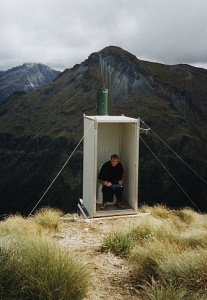
That night, over dinner of noodles and soup, I met a couple of English blokes called James and Simon and walked the remainder of the track with them. On the second day I had the distinction of being the last person out of bed in the whole hut (hurrah!) and we set off on the trail at 11.00am. We climbed to the summit of the nearby Mt. Luxmore then followed the trail as it wound along high ridges with more spectacular views of the mountains. As on the Tongariro tramp I was extremely lucky with the weather, and although there was some cloud the views were still terrific and there was no rain. We walked for about five hours that day, and eventually descended steeply back into the beech forest to Iris Burn hut, where we spent the second night. Next day we again set out late, at 11.00am, to make the walk to Motorau hut, five hours away. The scenery on this leg was less dramatic but it was still a pleasant walk. We finished the day on the shores of Lake Manapouri where the sandflies were biting incessantly. The final day's hike brought us back to Te Anau for a much needed shower and a few beers.
Milford Sound, Christchurch & Kaikoura, South Island: 12th-17th March.

No rest for the wicked. Next day I was off to Milford Sound to do a day's kayaking. The gorgeous weather I'd enjoyed on the Kepler Track had disappeared and in its place was a miserable day of low cloud and steady rain. Milford Sound is not, geographically speaking, a sound at all but a 22km long fjord. The near vertical glaciated valley walls rise more than 1000m above the water, and paddling around underneath them in a kayak makes you feel very insignificant. Words don't begin to describe how awesome Milford Sound was; photos can't capture the unbelievable scale of the place. It was truly breathtaking. All sense of scale is lost in Milford Sound. At one point our guide asked us to estimate how far we were from a spectacular waterfall that was making the cruise ships in front of it look like toys; our guesses ranged from 500m to 2 kms, but in actual fact we were 6kms away.
It was difficult to get good photos of the sound because as soon as I took my camera out of the dry bag the rain soaked it. I found myself sitting in the kayak wondering whether I should have just taken a cruise on one of the big ferries, from where I could have taken photos to my heart's content. But then I had to ask myself which was more important; the actual experience, or capturing it on Kodak?
Moving swiftly on then, a brief stop in Christchurch just to get a look at the place, before reaching Kaikoura on the eastern coast of the South Island. The big attraction here is marine mammals; the sea floor in the bay just off the coast drops down to a depth of 1500m, and warm currents from the Pacific meet cold waters coming up from Antarctica. The end result is an upwelling of nutrients that attract several species of whale, including sperm whales, and several kinds of dolphins. Thousands of tourists come to Kaikoura to either watch the whales or swim with the dolphins. I like to be a bit different when possible; there was a company offering caged dives with Blue and Mako sharks - both pretty dangerous. Unfortunately the weather at the time was not so good, and the sea was too rough to go out on the shark dive or even whale watching. Everything was cancelled and as I only had one day to spend in Kaikoura before making my way back to Auckland to fly out, I missed out altogether.
Nandi & Nanuya Lailai island, Fiji: 17th-25th March.
As I left Auckland bound for Fiji, I really wasn't in the mood for going back to the "developing" world. I arrived in Nandi after dark and when the sun came up next morning it revealed a grey, wet, humid scene that further dampened my enthusiasm for exploring Fiji. There was quite a friendly crowd of people in Sunseekers Hotel where I was staying, so I spent a soggy saturday and sunday lingering in Nandi.
Monday dawned bright and clear and I felt in much higher spirits, and in the mood to move on. I set off to find a bus that would take me up to Lautoka, Fiji's second city. After my hectic whistle-stop tour of New Zealand I was feeling the need to take things a little slower for a while. So from Lautoka I went out to a small island called Nanuya Lailai. The next island along, which we could walk to at low tide (but weren't allowed to because of the US$1000 per night resort) was the island where, back in 1979, they filmed Blue Lagoon starring Brooke Shields and the guy who nobody remembers.
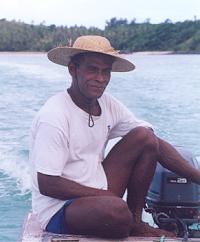
Life on Nanuya Lailai was very relaxed. Three huge meals a day were included in the US$15 daily price, and in between meals I was kept busy snorkelling, sunbathing, lying in the hammock, playing guitar... Evenings were spent playing cards, sipping beer and listening to Joe and friends playing their guitars and ukuleles and singing Fijian songs. This would go on until the generator went out at 11.00pm, although most days people were so exhausted from the day's stresses that they were in bed earlier.
The other activity that occurred each night was kava drinking, although I only took part on one occasion. Kava is a mildly narcotic substance derived from the root of a type of pepper plant. It is dissolved in water to form a muddy brown liquid that looks and tastes like cold dishwater. Drinking it involves a small ritual wherein you'll be offered a coconut shell full of kava. To accept, you have to clap your hands once and say "Bula!". Then you quickly drink down the liquid while everyone else claps three times. The effect of one or two shells of the stuff is to make your mouth and tongue go numb. Prolonged use is said to lead to relaxation and lethargy . I had eight shells of it but the only effect it had on me was to make me wake up all night needing to pee. Joe and his friends were up most nights past 2.00am drinking it.
On my third night on the island Joe took a few of us out for a sunset cruise around Turtle Island, across the Blue Lagoon and to Tavewa Island. We sipped our beers while Joe and friend played more Fijian songs as we cruised past the islands, and the sky slipped from blue to orange to pink as the sun set slowly over the South Pacific... A perfect way to spend an evening in paradise...

Next day Joe took us over to Navula Island to visit the village and also the local primary school, which was having its termly sports day. We watched the headmaster lead the kids in prayers, then heard them sing the Fijian national anthem. Afterwards we had lunch while we watched the boys play 7-a-side rugby and the girls play basketball. My stay in Fiji coincided with the Hong Kong Sevens tournament which Fiji were favourites to win. Everyone was glued to their TVs to watch Fiji's imperious progress through the group stage and knock-out rounds, including an embarrasingly easy 52-7 win over England in the semi-final. Their game fell apart in the final though and they were beaten by New Zealand, a result the Fijians took with typical grace and good sportsmanship.

From Nanuya Lailai I returned to Nandi, as I had booked a shark dive at Mana Island for the sunday. There must have been 40 divers from six or seven dive boats at the site, known as the Supermarket, that morning; we all lined up either side of a narrow break in the reef while a couple of brave dive guides knelt in the middle with a bucket of fish heads. About a dozen sharks were cruising around us, mostly black- and white-tip reef sharks but also four larger and more fearsome looking grey reef sharks. The sharks seemed to be a bit hesitant in going in for the fish and the divemasters were surrounded by remoras and butterflyfish nibbling at their fingers. One or two of the grey reefers went in and grabbed some fish; they weren't huge sharks, two metres maybe, but they were impressive enough when they extended their jaws and bared their ragged teeth. After about 20 minutes we moved off the reef slope and here, in deeper water, the sharks were more aggressive. I could hear the sound of them ripping the dead fish to pieces with furious shakes of their heads. I felt quite safe hovering in open water five metres above these potentially dangerous animals; somehow when I'm diving, I lose all fear of sharks although when I'm snorkelling and I see one it's a different story...
The following day I took the bus to the capital city of Fiji, Suva. There wasn't a lot to do or see there beyond the museum, but I felt the city, with its harbour and backdrop of rugged hills across the bay, had a certain charm. The place I was staying in was not far from the Government district, and to get to town I had to walk past both the British and American embassies. The contrast between the two buildings was interesting. The British embassy sat behind a low wall, the decorative iron gate ajar as if inviting passers-by in for a cup of tea and a chat about the weather. But the US embassy, Stars-and-Stripes hanging proudly from the roof, lay along a side street sealed off at each end by road blocks manned by armed police and big dogs. The USA has a way of making friends around the world...
Like Nandi and Lautoka, Suva has a large Indian population but unlike those other towns, it doesn't have such a strong Indian feel to it. In the 1800s the British brought over tens of thousands of people from India to work the plantations. The system was called "Indenture", although what it had to do with false teeth, I don't know... Now their descendants run all of Fiji's businesses and transport services. Get out of the towns, along the coast or into Viti Levu's mountainous interior and the villages you'll find are traditional Fijian.
Not that I went to any traditional Fijian villages. After Suva I headed to another beach resort on the Coral Coast between Suva and Singatoka, called the Beachhouse. The order of the day here was very similar to Nanuya Lailai, except it wasn't so pretty and there were far more people. I was there three days then it was time to leave Fiji and head for the US of A.
Next page: USA, Canada & Mexico